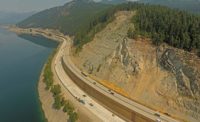Chip. Blast. Demolish.
Barnard Construction Co. of Bozeman, Mont., normally builds dams. But the firm is now winning awards for ripping them out. Removing the 108-ft-high Elwha Dam, built in 1913 just five miles from where the mouth of the 45-mile Elwha River runs into the Strait of Juan de Fuca in Washington State’s Olympic National Park, and the 210-ft-high Glines Canyon Dam, built in 1927, eight miles upstream from Elwha, marked the nation’s largest-ever dam removal and river restoration project.
For this, the project team captured the ENR Northwest Project of the Year.
Removing roughly 50,000 yd of concrete has never proven so dramatic, environment-changing and politically tricky. It took Dr. Brian Winter, Elwha project manager with the National Park Service, more than 30 years of work to finally see the concrete that impeded pristine mountain waters give way to permit the natural migratory runs of steelhead and seven salmon species.
“The true accomplishment was in the partnerships the National Park Service developed and maintained through the many years necessary to see this through to completion,” Winter says.
Part of that intricate planning—with a long list of agency sign-offs—involved Barnard carefully demolishing two dams in a methodical way not only to remove concrete from a National Park safely, but also to time the release of two pent-up reservoirs to properly send nearly a century of river sediment downstream without further eroding or harming a river that people wanted to restore.
“The most important goal of our work is maintaining the safety of every person on or around the project,” says Brian Krohmer, Barnard project manager. “In the case of the Elwha/Glines project, we accomplished this high-hazard work over the course of three-plus years in a sometimes harsh environment with zero lost-time, OSHA recordable, reportable or even first-aid injuries.”
Considering the rugged location and narrow canyons, the use of explosives, cranes and in-water demolition, Krohmer says he remains proud of the company’s accomplishment.
Barnard’s $29.7-million portion of the larger $325-million restoration effort included the careful removal of two aging concrete structures with no built-in fish passage. A sudden removal would not only have sent 800 acre ft of water rushing downstream, but also 24.3 million cu yd of gravel, silt and woody debris.
The demolition plan called for deliberate movements, with the NPS setting up fish windows during the 2011 through 2014 project that allowed fish time to acclimate to changing water conditions. The plan also restricted the amount of water that could be released during active working times and limited demolition to just over six months each year. Every time river levels dropped 15 ft, a plan put together in cooperation with the Bureau of Reclamation took effect, triggering a 14-day construction hold to erode the delta efficiently, Winter says.
Crews used two hydraulic hammers mounted on Caterpillar 330 excavators to chip away the Elwha spillway on one side and the dam on the other 4 ft at a time. Using earthen cofferdams, the team diverted the river back and forth about 10 times, working on the dry side after each movement. The switches allowed workers to not get too far below water levels for safety reasons and to keep the reservoir at the proper fish-friendly depth.
Work at Glines Canyon required a barge-mounted excavator with a hammer selectively notching the dam at varied elevations and dimensions because the dam was only 6 ft wide at the top. On the right-hand bank, a rock shelf pinched off work, not allowing the barge access, so crews used a crane-mounted drill to reach it.
As debris piled up and water levels dropped, crews started drilling and blasting with a nitroglycerine-based product, using the crane to move resources in and out. Krohmer says adding blasting to the mix eased maintenance headaches associated with the hammers and assuaged unknown safety concerns that come when resting large pieces of equipment on the crest of an aging dam.
The entire process was a rewarding one for Krohmer. “Barnard is typically involved in constructing and rehabilitating dams, not removing them,” he says. “We learned that although the end product is quite different, the planning and coordination involved to get there is similarly challenging and both are very rewarding in different ways.” The project opened up more than 70 miles of river and streams to migrating fish populations that had been denied access to all but five miles of the Elwha River and its tributaries for more than a century.
Removal of Elwha and Glines Canyon Dams
Port Angeles, Wash.
Key Players
Owner/Developer National Park Service
Lead Design Firm U.S. Bureau of Reclamation
General Contractor Barnard Construction Co.
Structural Engineering/Mechanical and Plumbing Engineering/Civil Engineering U.S. Bureau of Reclamation







Post a comment to this article
Report Abusive Comment